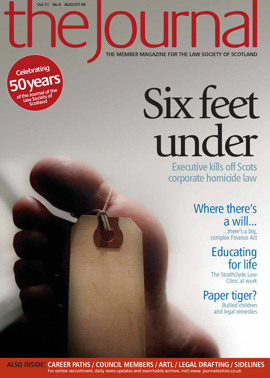The paper monster

On 12 July, a fire in the Iron Mountain storage facility in London’s Bromley-by-Bow district burned the building to the ground. The facility primarily stored archival and inactive business records and it is understood that several prominent law firms stored files there. Very large numbers of files are thought to have been destroyed.
This incident serves as a reminder that the potential for loss of large numbers of files and documents makes it appropriate to consider document storage as part of the practice’s business continuity management planning.
We reproduce here part of a risk management guidance note dealing with these issues.*
The challenge
Regardless of the method of storage of files, the file must be retained for a suitable period. This period depends very much on the nature of the subject matter. It is a matter of judgment for the practice as to how long to retain a file but, from a risk management point of view, protection of the solicitor as well as the client’s requirements must be considered. Guidelines issued by the Society, available on its website, include suggested retention periods.
The principal problem facing practices when considering the retention issue is a lack of storage space. When faced with a shortage of physical space, practices have a limited number of (not necessarily mutually exclusive) options:
- Move to larger premises/reorganise existing office space to create archive storage capacity. Neither of these options is usually feasible or desirable.
- Store archived files offsite. Many practices find this option useful – either by moving files to a lock-up garage or using a professional storage company. However, this option may involve additional expense.
- A regular clear-out of archive. Some practices are not particularly rigorous about purging closed files. This is often not a complete solution, since some practices find that even with such a regular clear-out, there is still a lack of space.
- Transfer to microfiche. Although this is an option, few practices seem to regard this as viable because of the resources involved in creating a microfiched archive, as well as the challenges of retrieval and distribution. It is also “yesterday’s technology” and would not represent a value for money option.
- Document/file scanning. Increasingly, practices are looking to this type of solution to assist with archive management.
Storage of archived files on CD/DVD/hard disk is a practical way of dealing with storage and retrieval difficulties.
Creating the “e-file”
It is possible that an electronic version of a file is created at the conclusion of a matter, the file (or at least the paper part) being scanned in one go, and the newly created electronic file archived.
The alternative is that the electronic version is created on an ongoing basis, i.e. “day forward” – where outgoing correspondence is retained in electronic form under the client matter reference along with incoming electronic correspondence. Incoming paper correspondence may be scanned on receipt and added to that electronic matter file.
The risk management issues are much the same, so for simplicity, let us assume that the electronic file is created at the conclusion of a transaction to facilitate archival.
Paper v electronic storage
The principal benefit to creating an electronic file is that it can resolve the problem of lack of physical space.
There seem to be no objections to creating an electronic scanned file from a professional indemnity insurance point of view.
Practices should take particular care when ordering destruction of the original paper file. Although there may not be any objections from insurers, and the electronic file may be regarded as equivalent to the original paper, certain documents in the file may belong to the client and permission may need to be sought prior to their destruction. Practices should take particular care not to inadvertently destroy documentation which should either be returned to the client or which must be retained in paper form (e.g. papers with original signatures such as deeds, guarantees or certificates which require to be preserved should not be destroyed without the express written permission of the owner).
Future access
An archive that cannot be accessed in 5 or 25 years’ time potentially puts the practice in a worse position than having a paper record. For instance, DVDs may well be susceptible to adverse environmental conditions such as dust, heat and light.
If and when the DVD format begins to become obsolete as a means of storing data, practices should have plans to review their storage arrangements and move records held on DVD to the next appropriate storage medium.
Resourcing
The format of electronic archives created may be dependent on the practice’s current IT system. Decisions as to the format of the file will be directly related to the resources that the practice is willing to commit to the creation of such an archive. Firms should carefully consider the method by which documents are to be stored.
Practices should also consider how much time may require to be spent scanning and indexing documents, as well as the capital outlay on specialised software. Coupled with the necessity to have staff employed scanning documents, some firms may decide to outsource this task. If outsourcing is being considered, practices should review the confidentiality and associated security issues involved.
Locating and indexing
From a risk management point of view, indexing is perhaps the most critical issue in relation to creating an electronic archive. Without proper indexing, retrieval will be, if not impossible, then very difficult without specialist help. It is extremely important that as part of the preservation strategy, the practice establishes naming and indexing standards for matters and individual electronic and paper files in order to build a comprehensive database of the archive.
In relation to the transfer of data into the electronic archive, firms should be wary of human error causing a difficulty either in indexing or actual storage of the file. A system of quality control including double-checking should be instituted.
In the event that the data is corrupted or indexed incorrectly in the electronic archive, the practice may well have difficulty in retrieving the data.
Back-up
Back-up of the archive may be considered appropriate. However, considering the smaller amount of physical storage required for the electronic archive, it may be easier to protect the archive. The points regarding degradation of media and data migration mentioned above should be considered when deciding on physical storage.
Questions
Practices thinking of reducing pressure on storage by creating an electronic archive should make sure they have considered:
- the appropriate method of storage;
- how migration of documents would be accomplished;
- the different methods available for archiving electronically and the merits of each;
- how to ensure effective indexing;
- how to plan and manage the project cost effectively.
Without adequately addressing these issues, your practice will be exposed to risk.
Charles Sandison is a consultant with the FinPro (Financial and Professional Risks) Practice at Marsh, the world’s leading risk and insurance services firm.
To contact Charles, email: charles.sandison@marsh.com
This briefing is based on Marsh’s Document Archiving Risk Management Guidance Sheet, which can be obtained on request from the Marsh Team
From the Journal archive: other useful articles
See also Controlling paper and electronic files (on the risk management aspects of controlling files, both paper and electronic) by Alistair Sim, Marsh Ltd in Journal, November 2000, 46; www.journalonline.co.uk/article/1000983.aspx
For articles on the subject of business continuity planning in previous issues, please refer to:
- Who would steal our files? (on the potential implications and the risk control points arising from the theft of files or equipment) by Alistair Sim, Charles Sandison, Marsh Ltd: Journal, June 2001, 42; www.journalonline.co.uk/article/1000954.aspx
- Be prepared (on the need for business continuity planning and how addressing just a few issues can make a worthwhile difference) by Russell Lang, Marsh Ltd: Journal, December 2004, 35; www.journalonline.co.uk/article/1001313.aspx
- Continuity planning takes drama out of a crisis (how continuity planning retains management control when unforeseen events happen and should be an important part of risk management strategy) by Alistair Sim, Charles Sandison, Marsh Ltd: Journal, May 2003, 38; www.journalonline.co.uk/article/1000009.aspx
Highlights of the Roadshow review
The 2006 series of Risk Management Roadshows ran from April to June 2006. The series comprised nine events across Scotland (one a video linked session for three outlying locations). The events continue to attract high numbers of delegates, with 269 taking part this year.
The objectives of the 2006 Roadshow were:
- To provide a forum for discussion of issues of risk and practical risk management
- To raise awareness of current risk issues facing the profession
- To encourage follow-up risk management activity on the part of delegates’ practices
- To provide delegates with ready-made materials for further learning.
The discussion topics were prepared by Marsh to reflect both current claims experience and issues likely to be of concern to the profession now and in the future. Each topic highlighted issues relevant to common underlying causes of claims, without requiring delegates to have an understanding of any particular area of law or practice.
Over 70% of delegates completed a Marsh feedback form. The responses were analysed to establish whether the objectives had been met. The table shows positive responses as a percentage of the 199 feedback forms completed.
- Discussion topics were relevant - 100.0%
- Group discussion format useful - 100.0%
- Will consider making changes to systems - 91.5%
- Will recommend materials are used for in-house training - 79.9%
- Discussion format a worthwhile way of learning - 98.5%
- I learned something useful about risk management - 97.5%
- I found the case studies engaging/challenging - 94.5%
- Attendance was worthwhile - 99.5%
In total, 99% of delegates rated the Roadshow “good” or “excellent”, an increase on 2005’s figure of 97%. We are delighted that the investment of resources in the Roadshow continues to achieve such high levels of engagement and satisfaction across the profession.
The feedback helpfully provided by delegates is the ultimate test of success and we believe the Roadshow’s objectives are convincingly achieved by delivering an interactive format that delegates find enjoyable, satisfying and an effective method of learning.
The Roadshow is regarded as a key CPD event by many in the profession and it continues to justify the time and resources devoted to it. The workshop format relies on the participation of Master Policy panel solicitors, members of the Pursuers’ Panel, representatives of the LDU and members of the Society’s Insurance Committee. Their support is very much appreciated.
Training materials will be issued to delegates and made available on our website for Scottish solicitors.
This briefing has been extracted from Marsh’s Risk Management Roadshow Report 2006 for the Law Society of Scotland (15 June 2006). The full report can be downloaded from Marsh’s Scottish solicitors’ website at www.marsh.co.uk/lawsociety
In this issue
- Ireland 4, Italy 0
- A lack of trust
- Technology and the Scottish courts
- For supplement read tax - an update
- Eyes on the ball
- Don't leave gaps in regulation
- Keeping company
- Fighting the bullies
- The university of life
- A lack of trust (1)
- With these few words...
- Tell it like it is
- All that sparkles ain't gold
- PDF is the standard
- The paper monster
- Safeguarding fair trial
- New law, new problems
- Raising the stakes
- Mark the pre-proof
- Scottish Solicitors Discipline Tribunal
- Website reviews
- Book reviews
- It takes two to tango
- Land attachment and suspensive missives
- PSG's suite moves






